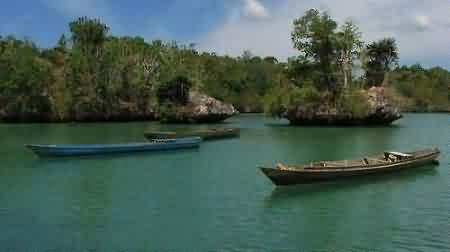 On the south coast of central Lombok, just hit Putri Nyale Beach. It stretches an unbroken expanse of clean white sand lapped by waves of the Indian Ocean. From Sulawesi, Indonesia has two marine spot you must visit, Bunaken in North Sulawesi and Wakatobi in South East Sulawesi. In Papua, don't ever miss The Raja Ampat Island. It possibly holds the richest variety of species in the world.
On the south coast of central Lombok, just hit Putri Nyale Beach. It stretches an unbroken expanse of clean white sand lapped by waves of the Indian Ocean. From Sulawesi, Indonesia has two marine spot you must visit, Bunaken in North Sulawesi and Wakatobi in South East Sulawesi. In Papua, don't ever miss The Raja Ampat Island. It possibly holds the richest variety of species in the world.Indonesia for Shopaholic and Gourmet Traveller
For shopaholic, you could shop till you drop in Jakarta. Check out the Jakarta's modern shopping havens; Java is handicrafts galore, batik and most of the crafts made in Solo, Central Java and the villages around Yogyakarta, Bandung in West Java is a paradise for those who love garments, Shopping in Bali can offer excellent bargains. Shops that cater mostly to tourists sell modern artwork, leather goods, casual summer clothing and of course beach wear.
For culinary travel, Indonesia offers heaven gourmet. Travelers love eating and food is a big attraction. The most popular Indonesian cuisine is Sate (Satay), grilled meat skewered on wooden sticks, served with a sweet peanut or turmeric sauce.

Indonesia offers a great taste. Try hot and spicy rendang in Padang restaurant, the sweet Gudeg in Yogya. Soto mie, noodle soup with beef and cabbage from Bogor West Java, brown color broth beef soup "Rawon" from East Java, tangy fish dishes and red bean soup in Manado restaurant, spicy ribs soup from Makassar, Sulawesi.
Ecotourism Enthusiast and Avid History
For ecotourism enthusiast, there are many national parks worth visit. Go to Bukit Lawang in Medan. It is the first orang-utan rehabilitation center. Indonesia will continue stunning you at Kerinci Seblat National Park in Padang, a tropical rainforest heritage of West Sumatra, Siberut National Park-a man and biosphere reserve. Continue your eco journey to Way Kambas National Park-home to rhino and elephants in Lampung.

In Java, there are Gunung Halimun National Park-the land under the rainbow and Gunung Gede-Pangrango National Park as the most visited national park in West Java. If you want to see a land above the clouds, go to Bromo-Tengger-Semeru National Park in East Java.
For avid historical place, there are many relic sites you should visit Indonesia. Go to Batu Sangkar in Bukit Tinggi, West Sumatra, center of Minangkabau culture. Megalithic remains found in the area support the theory of a large community living in the area some 2000 years ago. Carry on to Riau, there is a buddhist temple, Muara Takus Temple.
Grab The Bookmarketer For Your Site
















